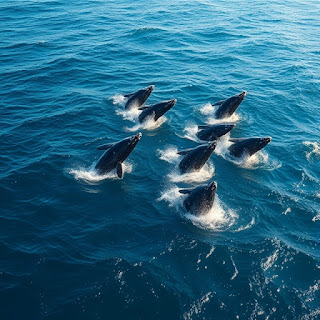A Deep Dive into Earth's Most Vibrant Ecosystems
Earth, our magnificent blue marble, is teeming with life. From the depths of the ocean to the peaks of the highest mountains, our planet is home to a staggering array of species and ecosystems. In this blog, we'll embark on a journey to explore the top 10 most biologically diverse ecosystems on Earth. These vibrant hotspots of life are not only breathtakingly beautiful but also crucial for the planet's ecological balance.
 |
| stunning underwater coral reef, showcasing the incredible biodiversity of marine ecosystems |
1. Tropical Rainforests
Tropical rainforests are often hailed as the "lungs of the planet" due to their vital role in oxygen production and carbon sequestration. These lush, verdant ecosystems are characterized by high rainfall, warm temperatures, and incredible biodiversity. The Amazon rainforest and the Congo Basin are two of the most well-known examples.
 |
A dense canopy of the Amazon rainforest, home to countless species of plants and animals. |
2. Coral Reefs
Coral reefs are underwater cities of color and life, teeming with a dazzling array of marine organisms. These intricate ecosystems provide habitat for countless species, from tiny plankton to majestic sharks. The Great Barrier Reef off the coast of Australia is the largest coral reef system in the world.
 |
| A colorful coral reef teeming with marine life, including clownfish and sea anemones |
3. Mangrove Forests
Mangrove forests are unique coastal ecosystems that thrive in intertidal zones. These hardy trees are adapted to survive in salty, waterlogged conditions and play a crucial role in coastal protection, carbon sequestration, and biodiversity conservation. The Sundarbans in the Bay of Bengal is one of the largest mangrove forests in the world.
 |
| A dense mangrove forest, providing habitat for a variety of bird species |
4. Temperate Forests
Temperate forests are found in regions with distinct seasons and moderate climates. These forests are characterized by diverse tree species, including oak, maple, and beech. The Pacific Northwest of North America and the temperate rainforests of Chile are two notable examples.
 |
| A stunning autumn forest with colorful leaves, showcasing the beauty of temperate ecosystems |
5. Grasslands
Grasslands are vast expanses of land dominated by grasses and other herbaceous plants. These ecosystems are home to a diverse range of herbivores, including bison, zebras, and wildebeest. The Serengeti National Park in Tanzania is a world-renowned grassland ecosystem.
 |
| A herd of zebras grazing in the African savanna, a classic grassland ecosystem |
6. Wetlands
Wetlands are areas of land that are saturated with water, either permanently or seasonally. These ecosystems play a vital role in water filtration, flood control, and biodiversity conservation. The Everglades National Park in Florida is a prime example of a wetland ecosystem.
 |
| A tranquil wetland with a variety of bird species, including herons and egrets |
7. Tundra
Tundra is a cold, treeless biome characterized by low-growing vegetation and permafrost. Despite the harsh conditions, the tundra supports a diverse array of wildlife, including polar bears, arctic foxes, and reindeer.
 |
| A breathtaking winter landscape in the Arctic tundra, showcasing the beauty of this cold biome |
8. Desert
Deserts are arid regions with little rainfall and extreme temperatures. Despite the harsh conditions, deserts are home to a surprising diversity of life, including cacti, reptiles, and insects. The Sahara Desert in Africa is the largest hot desert in the world.
 |
| A majestic sand dune in the Sahara Desert, a symbol of the world's largest hot desert |
9. Marine Ecosystems
Marine ecosystems cover over 70% of the Earth's surface and are home to a vast array of marine life. From the sunlit surface waters to the dark depths of the ocean, these ecosystems support a diverse range of organisms, including fish, whales, and invertebrates.
 |
| A majestic pod of whales breaching the surface of the ocean, showcasing the beauty of marine ecosystems |
10. Freshwater Ecosystems
Freshwater ecosystems, such as lakes, rivers, and wetlands, are essential for life on Earth. These ecosystems provide habitat for a diverse range of aquatic organisms, including fish, amphibians, and invertebrates. The Amazon River basin is one of the most diverse freshwater ecosystems on the planet.
 |
| A tranquil lake with diverse aquatic life, including fish and water lilies |
Earth's biologically diverse ecosystems are a testament to the incredible power of nature. By understanding and appreciating these vital habitats, we can work to protect them for future generations. Let's commit to conserving these precious ecosystems and ensuring a sustainable future for all life on Earth.



No comments:
Post a Comment